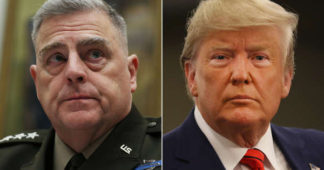It’s heavy on scoops and light on analysis.
By Fred Kaplan
September is the month of renewed beginnings: the autumn equinox, the start of the school year, the U.N. General Assembly, and, in recent years, the appearance of a new Bob Woodward book. It’s happened in three of the past four Septembers, with each volume of his bluntly titled Trump trilogy—Fear (2018), Rage (2020), and now Peril (2021), the last co-authored with Robert Costa.
The seasonal routine has already hardened into ritual. His longtime employer, the Washington Post, previews a few of the book’s most breathless scoops; the scoops are discussed (often inaccurately) on every TV news show; by pub date, the book has rocketed to the top of the bestseller list. The books themselves also follow a pattern, so consistent, over the past few decades, that it might be dubbed “Woodwardian.” The author amasses vast quantities of scoops, some of them extraordinary. He subjects them to little, if any, analysis. Instead, he channels his anecdotes through the viewpoints of well-known characters, who tend to be either heroes (who often coincide with sources who have told him a lot) or villains (who usually haven’t).
This last trait is common among Washington journalists who rely too much on insider sources, but Woodward takes the practice to extremes. The main hero in Peril, as many have noted, is Gen. Mark Milley, chairman of the Joint Chiefs of Staff, who is portrayed as the warrior-savior who kept the world at peace during Donald Trump’s most turbulent outbursts. Milley exaggerates, and Woodward lets him. (In a column last week, I scrutinized the claims about Milley’s alleged subversions of Trump’s war powers.)
Woodward’s credulity of his favored sources taints his own credibility on matters large and small. For instance, there’s a passage describing the events of June 1, 2020, as protests are erupting, some violent, in reaction to the police killing of George Floyd. News footage that day revealed Milley strutting through the streets of downtown Washington, D.C., in combat fatigues, as if he were inspecting the troops in wartime. He was much criticized for this and, 10 days later, apologized. But Woodward treats the general’s wardrobe as innocuous, writing, “Milley left the White House and headed downtown to visit the FBI command post monitoring the demonstrations. Expecting a late night, he changed into his uniform of camouflage fatigues to be more comfortable.”
I have no doubt this is the explanation Milley fed him. I am stunned that, after 45 years of high-level journalism, Woodward still lacks a functioning bullshit detector.
For one thing, there was no reason for the JCS chairman—who has no role in the chain of command for overseas combat operations, much less for domestic protests—to be out on the streets in any case. For another, I am unaware of any chairman donning combat fatigues, except perhaps when visiting troops abroad, for any purpose. Finally, Milley did this in the middle of the day—in fact, he appeared in fatigues when posing with the Bible-toting Trump in front of the church near Lafayette Park (an incident that Milley regretted soon after)—so he would have had no idea how late the night would go.
Another, more puzzling hero in this book is Attorney General William Barr. It has been widely reported that, toward the end of his term, Barr disagreed with Trump, in some cases openly; it is also the case that, in recent months, Barr has been talking with several authors in an effort to dissociate himself from the twice-impeached former president. In this aim, Woodward grants Barr full clemency. He underplays Barr’s preemptive distortion of the Mueller report, to the point where it doesn’t seem a distortion at all. He writes nothing of Barr’s complicity with some of Trump’s most egregious violations of civil liberties. He even writes that Barr started out as a respectable conservative, then moved right in response to attacks from the left—thus ignoring Barr’s longtime activism with the Federalist Society and Opus Dei.
Woodward even gives a hearty pat on the back to Secretary of State Mike Pompeo, who, in this account, derides Trump’s postelection legal team as “crazies” and, along with Milley, talks Trump out of attacking Iran. The book says nothing of Pompeo’s incessant campaign for Iranian regime change in the years before Trump’s final hours.
And, as was true in his previous book, Rage, Woodward good-naturedly tolerates Sen. Lindsey Graham, who unloads an endless stream of wild stories about Trump’s wacky ways. Graham keeps coming back to Trump for another round of golf, even after he has left the White House, on the premise that the Republicans can’t win without Trump but also can’t win unless Trump changes—though, after each bizarre conversation, Graham realizes the man is incorrigible. “But there was no changing him,” Woodward writes, channeling Graham. “You just kept the conversation going.”
But why keep this conversation going? It’s a question that comes to mind over and over while reading this book, though Woodward never poses it explicitly: Why did (and why do) so many otherwise intelligent Republicans put up with the shit that Trump flings their way? Yes, the Republican “base” loves Trump; but if they know, as Graham does, that the party can’t win a general election if Trump doesn’t abandon his nuttier ideas or his self-destructive manners, why aren’t they looking for an alternative path to power?
In one of Woodward’s scenes, a Cabinet meeting where several officials oppose Trump’s desire to crush anti-police protests with active-duty soldiers, Trump responds by throwing a tantrum, screaming, “You’re all fucked up. Everybody. You’re all fucked. Every one of you is fucked up! … Everybody get out of here!” In another scene, CIA Director Gina Haspel fears Trump is moving toward “a right-wing coup.” In still another, House Speaker Paul Ryan better understands Trump by reading a paper, sent to him by a doctor, on narcissistic personality disorder. The Senate’s top Republican, Mitch McConnell, describes the Trump years as “so many Maalox moments.” Yet no Cabinet secretary, and fewer than a handful of congressional Republicans, moved to get this guy out of office through impeachment or the 25th Amendment. Even now, few Republicans express qualms, in public anyway, about a return of Trump to office, and those who dare to do so—such as Rep. Liz Cheney, who, on policy grounds, is as conservative as they come—are thrown out of the party’s leadership.
Why is this? Woodward and Costa don’t go there.
Like many of Woodward’s past works, this is less a cohesive book than a string of anecdotes, some hair-raising, some less so than they appear to be. Perhaps because it was churned out so quickly, this book contains some very intriguing bits—the hints of a story, but not quite the follow-through—that someone should investigate more thoroughly. The most intriguing of all is a previously unreported episode of the Jan. 6 storming of the Capitol. Several rioters, it turns out, tried to break into the private office of James Clyburn, the Black South Carolina congressman whose endorsement of Joe Biden probably won the former vice president the Democratic nomination. As the book puts it, “Clyburn was alarmed. Was he being targeted? Was this an inside job? His private office was all but unmarked. Why hadn’t the rioters gone to his public office that had his name on the door? How do they know this location?” All good, tantalizing questions. Will there be an addendum to the paperback edition?
The book also reports that “U.S. intelligence showed the Jan. 6 riots … not only stirred up China but caused Russia, Iran, as well as other nations to go on high alert to monitor the American military.” Go on.
In the later chapters, which deal with the first few months of the Biden administration, the book reports that, in one of 25 National Security Council meetings held on whether to withdraw troops from Afghanistan (an extraordinarily high number of meetings), Biden asked how much warning time he would have before a terrorist group like al-Qaida reconstituted itself. “We should have six months warning,” the intelligence officials said. Especially in light of the rapid collapse of the Afghan government and the Taliban’s equally rapid ascension to power in the wake of the U.S. withdrawal, it would be good to know which intelligence officials said this. (Woodward and Costa should consider tacking on a whole new chapter to the paperback edition on this question alone.)
The Biden section is quite interesting, especially the lengthy tick-tock on how he and his aides pushed Sen. Joe Manchin, the conservative West Virginia Democrat, to support the infrastructure bill. It’s an instructive piece of journalism on the nuts and bolts of how a bill really gets passed in today’s often-dysfunctional Congress. It’s also gripping. However, it has nothing to do with the rest of the book. It might have, if Woodward and Costa had used the story to draw distinctions between Trump’s “clown show” and Biden’s more traditional, if constrained, style of politics—but the authors don’t do that. There isn’t much narrative structure here at all, beyond this happened, then this happened, then this happened …
That said, Peril is a more breezily written book than the other Trump volumes, maybe more so than any Woodward book since his collaborations with Carl Bernstein. (Maybe having Costa as a collaborator helped.) It’s entertaining, there are plenty of new details, and, as much as any of the dozens of books out there about Trump, it sets off alarms, all over again, that a man so childish, egomaniacal, and unstable could have been—and might again be—the most powerful man on earth. Ben Wittes of Lawfare once described the Trump administration as “malevolence tempered by incompetence.” Peril dramatizes both elements. As Woodward and Costa write in uncharacteristically editorializing terms early on in the book, “What is your country? What has it become under Trump?”
Published at slate.com
We remind our readers that publication of articles on our site does not mean that we agree with what is written. Our policy is to publish anything which we consider of interest, so as to assist our readers in forming their opinions. Sometimes we even publish articles with which we totally disagree, since we believe it is important for our readers to be informed on as wide a spectrum of views as possible.










